THE WILLCOX
& GIBBS SEWING MACHINE COMPANY
AND THE WEST VIRGINIA CONNECTION
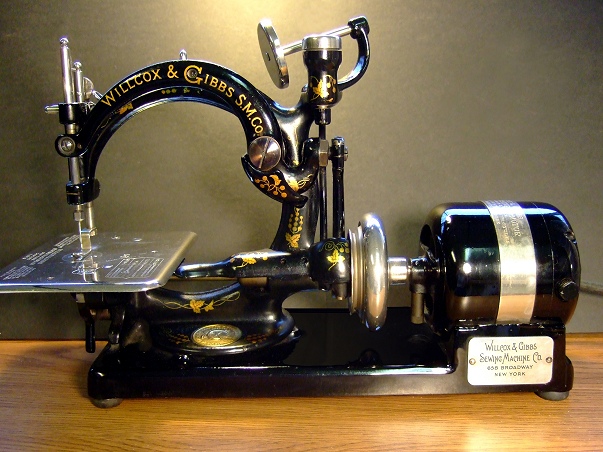
My interest in this machine
|
I
have always had an eye for beautiful machines. Early sewing
machines were often considered the most beautiful of all the machines
man had made up to that point. Only early guns and clocks
rivaled sewing machines for beauty.
I was an upholsterer and had seen many old
machines, but never really thought of owning one just for the
heck of it. But this one was
different.
First however,
I came home and did some research on it. As I soon
learned, the company had quite a history which only added to
my interest in owning it. The following day I bought it. Turns
out that my machine is museum quality. There are very few left in
this condition and I have yet to see one as good as mine.
|
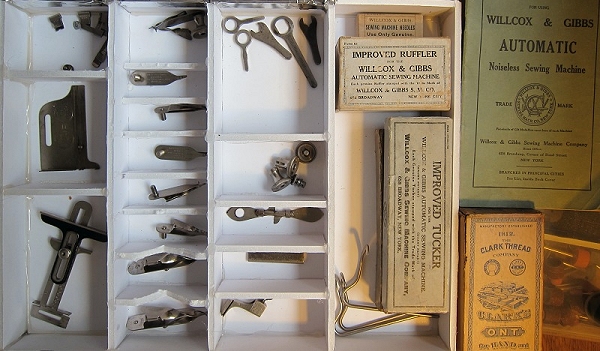 I have every part made for this machine and then some.
If
you've ever opened a big bag of flour, pet food, salt, litter, or any
of a hundred other items that come in a bag with a sewn top,
you've used the process that James Gibbs
invented:
The Chain Stitch Sewing Machine. |
|
HERE'S THE WV CONNECTION
ON THE DIVIDING LINE between Augusta and Rockbridge counties Virginia
lies Walnut Grove, home of Cyrus Hall McCormick, inventor of
the reaper. McCormick's invention assured him of lasting fame and
recognition, but in a nearby village lived another inventor whose
accomplishments were overshadowed by his competitors and whose work is
little remembered outside his native Rockbridge county.
James Edward Allen Gibbs invented a sewing machine and founded a company to
market it which is still in existence today. He is the only inventor
outside of the New England states to produce a sewing machine. Yet
Elias Howe and Isaac Singer are the names usually associated with the
history of the early sewing machine and few have ever heard of James
Edward Allen Gibbs.
From 1845 until 1856 when he patented his sewing
machine, Gibbs worked at various occupations and in several different
locations. For awhile he rented a building and operated a carding mill
( Before wool can be spun into yarn for knitting or weaving into cloth,
it first must be brushed, or carded ) in Lexington Virginia, but
finding himself debt ridden, he left there in the early 1850s and went
to Huntersville in Pocahontas County, now in West Virginia.
(Huntersville still exists and is only 6 miles East of Marlington)
Gibbs became a partner in another carding business, but sold his
interest when that business, too, proved to be unsuccessful.
After leaving the carding business, Gibbs engaged
in a variety of activities. He joined a surveying team in Randolph
County, also in present-day West Virginia. On a surveying expedition
he suffered a serious injury when, while cutting down a small pine
tree, his ax slipped, cutting through his right knee cap. His
companions took him to the home of Alexander Logan at Mingo
Flat (the town is still there half way between Snowshoe and
Valley Head WV) where for six months the Logan family, and especially
William Logan, nursed him through to his recovery.
(After
the Civil War, when fortune had favored Gibbs and taken everything from
William Logan, Gibbs aided Logan in establishing a store at Midway,
Virginia.) The knee injury, however, prevented
Gibbs from resuming his career as a surveyor and he became a carpenter
and a millwright. In the winter of 1851-52, he built a grist and
sawmill for Colonel Samuel Given in Nicholas County.
While
engaged in this project, he met Colonel Given's daughter, Catherine.
The dark-haired young man with the big nose and sharp blue eyes could
not have been called handsome, but he had a strong personality, and a
social nature that Catherine must have found charming for they were
married on August 25, 1852.
Refusing his father-in-law's offer of 500 acres of
land and the equipment to start a farm, Gibbs returned with his wife to
Pocahontas County where he continued to work as a carpenter.
Elias Howe, William O. Grover, William E. Baker,
Isaac Singer and others, patented sewing machines in the early 1850s
and revolutionized the clothing industry. In 1855, Gibbs saw a woodcut
of a Grover and Baker sewing machine in a newspaper advertisement. It
was the first image of these new contraptions that he had seen and
there was little to show him how it worked.
All that was shown
in the woodcut was the top half of the machine. Nothing indicated that
more than one thread was used to form the stitch or indeed how the
stitches were made. Gibbs decided that only one thread was used and
since his curiosity was aroused, he formed in his mind a method for
producing a single thread stitch. He later described the experience,
saying:
"As
I was then living in a very out-of-the-way place, far from railroads
and public conveyances of all kinds, modern improvements seldom reached
our locality, and not being likely to have my curiosity satisfied
otherwise, I set to work to see what I could learn from the woodcut,
which was not accompanied by any description.
Gibbs's
curiosity had been satisfied and he did not immediately pursue the
matter because he did not realize the significance of his invention.
However, in January 1856, when he was visiting his father in Rockbridge
County, he happened to enter a tailor's shop and there saw a Singer
sewing machine. Although Gibbs was impressed by the machine, he thought
that it was "entirely too heavy, complicated, and cumbersome, and the
price exorbitant". He remembered his own simpler invention and decided
to work seriously on a less-expensive sewing machine.
James
E. A. Gibbs was hampered in his attempt to perfect his sewing machine
because he had to support his growing family and could only work on the
invention at night and during inclement weather. In addition, he lacked
proper tools and sufficient materials.
After months of
effort, Gibbs succeeded in making, with his pocket knife, a crude
wooden model. He made the needles for the machine himself and,
according to his daughter, used the flexible root of mountain ivy to
fashion the revolving looper which was the key to his invention. By
April 1856, it was almost ready and Gibbs reportedly sold a half
interest to John H. Ruckman, local owner of a sawmill, in order to pay
to have the machine patented.
Gibbs could whittle
and invent, but he realized that he could not market his machine alone.
With his letters of patent in his pocket, he went to Philadelphia.
"I
was in Philadelphia in 1857", he later wrote, "selling the first of my
first two inventions in the office of Emery, Houghton and Company, when
James Willcox came in. He remarked that he was a dealer in new notions
and inventions, and he asked me to come to his little shop in Masonic
Hall and build a model of my machine".
Gibbs
worked with Willcox's son Charles to build a patent model and on June
2, 1857, he was awarded patent number 17,427 on his machine. As a
result of the successful patenting of the machine, Willcox and Gibbs
soon formed a partnership. In 1858, Willcox engaged the firm of J. R.
Brown and Sharpe of Providence, Rhode Island, to produce the sewing
machines and the first ones were manufactured in November 1858. To
market their machine, Willcox and Gibbs opened an office at 658
Broadway in New York City the following year.
Not
only had Gibbs successfully designed a simpler machine than the Singer
model he had seen in Rockbridge County in January 1856, but his new
sewing machine was also much less expensive. The Willcox and Gibbs
machine, sold on a simple iron-frame stand, cost $50 at the end of the
1850s compared to a cost of $100 for the machines produced by Wheeler
and Wilson, Grover and Baker, and Singer.
|
Here
is a very abbreviated version of the Willcox & Gibbs
story.
|
GETTING
THE first Willcox and Gibbs machine from drawing board to the shop
counter was an adventure beset with more engineering problems than
most. Willcox, who was in charge of production, approached
the
Providence, Rhode Island, company of Brown and Sharpe who were at that
time makers of clocks, watches and measuring instruments, and asked if
it would be interested in producing the new sewing machine. The project
was turned over to one very young man, Henry LeLand, who later would
design and build the Cadillic and Lincoln automobiles.
Work
began in March 1858 when the first drawings were made and soon the
local New England Bull Company was busy on the frame castings. When the
figures were finally totaled, it was found that Brown and Sharpe had
spent 10 times its original budget just on the tooling for the machines.
But
in October 1858 it all came together. Sharpe wrote to Willcox saying
that the first 50 machines were on the final assembly benches and that
the firm was now able to produce at the rate of 5000 per year.
Fortunately, for all concerned, the machine was an instant success, and
the small tool room quickly became a factory, continuing to make the
W&G machines well into the 1970s. Brown and Sharpe continued with its instrument
business and developed a world-famous name for selling specialized
machine tools to other sewing-machine manufacturers.
|

Early Willcox & Gibbs
sewing machine
CIVIL
WAR IN WEST VIRGINIA
|
In 1860, James E A Gibbs was 30 years old and had
attained a modest degree of financial success. The Pocahontas County
census of that year listed his occupation as a machinist and valued his
real estate at $2,000, while his personal estate was worth $15,647.
Immediately after the news of the firing on Fort
Sumter, in April, 1861, he left Providence to live on the farm he had
purchased in Pocahontas County. Matters political had a keen interest
for Gibbs. He was a Democrat, and in the state campaign of
1855 he had made speeches in Pocahontas in favor of Henry A. Wise as a
candidate for governor. For the Lewisburg Chronicle he wrote a parody
in ridicule of the American, or Know Nothing, party. In the present
crisis his sympathies were with the extreme Southern program. He went
on the stump in advocacy of secession, and went to Richmond to get arms
and uniforms for the first company of cavalry. These
uniforms were sewed on two of his machines. Old guns and pistols were
repaired in his shop. He went out with the Pocahontas cavalry, but his
constitution was never strong, and in three weeks he was sent home, ill
with typhoid- pneumonia. The advance of a Federal army caused Gibbs to
return as a refugee to his native county and neighborhood. He bought
the farm near Raphine which became the nucleus of an extensive
possession. In Rockbridge he was assigned to the ordnance service to
superintend the making of saltpeter. When General Hunter approached, he
was ordered out with his twenty men, and they fought in the battle of
Piedmont. ***See battle below***
After
the war, Gibbs decided to go to New York to discover if anything
remained of his sewing-machine business. Borrowing a broadcloth suit
from a brother-in-law, he left Virginia in June 1865. His daughter,
Ethel, recalled later that her father was followed from Jersey City to
658 Broadway in New York by a Northern detective who thought he was a
man named "Gibbs from Louisiana, who had invented the famous mortar
used by the Confederate Army". When Gibbs entered his old office, the
detective evidently realized he had the wrong man. James and Charles H.
Willcox greeted Gibbs with open arms and told him that they had
deposited $10,000 in the bank to his credit. The two Willcox men had
not made it public that the credit was for a Confederate because the
money would have been confiscated.
The inventor was now, at the age of thirty-six, and
for the first time in his life, a dweller on Easy Street. In 1880, for example, Gibbs enjoyed a
combined income of about $10,550 including over $9,000 in bonds and
notes. He refused to become an officer of the Willcox and Gibbs company
when it was incorporated in New York as a stock company in 1866. He
preferred, as did his wife, to live in the two-story brick home he had
built on his farm.
Christened
Raphine Hall, from the Greek word raphis, meaning needle, the house was
large and comfortable and included a wing where Gibbs worked on his old
inventions as well as new ones. In 1883, he gave a right of way to the
Baltimore and Ohio Railroad to build its line and the land for the
station, which he also named Raphine.
Gibbs
continued to work with his company until about 1886. During that time
he traveled widely, especially in Europe, to promote the sales of the
Willcox and Gibbs sewing machines.
|
FINAL NOTE:
|
Among
those who worked on Willcox and Gibbs machines at the Brown and Sharpe
factory was one Henry Leland who was in charge of the sewing-machine
department from 1878 until 1890. Leland went on to devote his skills that he had
learned on sewing machines to forming the prestigious Cadillac Car
Company .
|
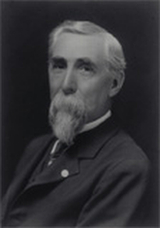 |
Henry
Martyn Leland (February
16, 1843 – March 26, 1932) was a machinist,
inventor, engineer and automotive entrepreneur who founded the two
premier American luxury marques,
Cadillac and Lincoln. He, as a young man, was in charge of
manufacture of the Gibbs sewing machine.
|
| He
was born in Barton, Vermont and learned engineering and precision
machining in the Brown & Sharpe plant at Providence, Rhode
Island,.
He
subsequently worked in the firearms industry, including at Colt. These
experiences in toolmaking, metrology, and manufacturing steeped him in
the 19th-century zeitgeist of interchangeability. He applied this
expertise to the nascent motor industry as early as 1870 as a principal
in the machine shop Leland & Faulconer, and later was a
supplier of
engines to Ransom E. Olds's Olds Motor Vehicle Company, later to be
known as Oldsmobile. He also invented the electric barber clippers, and
for a short time produced a unique toy train, the Leland-Detroit
Monorail.
He created the Cadillac automobile, bought out by General Motors. He
also founded Lincoln, later purchased by the Ford Motor Company. |
The Brown and Sharpe factory was
instrumental in inventing or perfecting the tools necessary to make
everything we use today from metal. From automobiles to
spaceships, they all started with Brown and Sharpe when they
invented two main tools: The Universal Milling Machine and
the Universal Grinding Machine. They also perfected the
Universal Screw Machine, for without, little could
be precisely made. All of these inventions were due to the Willcox and
Gibbs sewing machines, and the need to make them faster and better.
Today:
Rexel, the world's largest distributor of electrical parts, bought a
controlling interest in Willcox & Gibbs, and since
Rexel was not interested in serving the apparel industry, it sold this
segment of Willcox & Gibbs's business to WG, Inc. for about $44
million in cash, stock, and warrants and moved the company's
headquarters from Manhattan's garment district to Coral Gables,
Florida. In 1995 Rexel, S.A. raised its stake in Willcox &
Gibbs to 44 percent and changed the name of the company to Rexel Inc. |
To read the entire
article, follow these links:
James Gibbs
The Willcox
& Gibbs Company
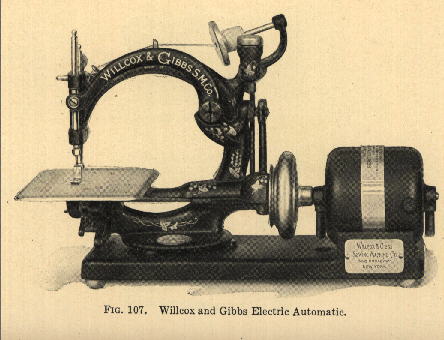
***The
Battle Of Piedmont***
| Significance: On 5 June 1864, the US army of
General David Hunter crushed the smaller Confederate army at Piedmont,
killing the CS commander (General ``Grumble'' Jones) and taking nearly
1,000 prisoners. Piedmont was an unmitigated disaster for CS arms in
the Valley. The disorganized Confederates could do nothing to delay
Hunter's advance to Staunton, where he was reinforced by Brig. Gen.
George Crook's Army of West Virginia marching from the west. United,
the US forces moved on Lynchburg. Hearing of Jones' defeat, Gen. Robert
E. Lee first rushed J. C. Breckinridge's division back to Rockfish Gap
and then detached the Second Corps of the Army of Northern Virginia
under Lt. Gen. Jubal Early to confront Hunter at Lynchburg. This
detachment severely limited Lee's ability to undertake
defensive-offensive operations on the Richmond-Petersburg lines and
served to open up the Shenandoah Valley as a second front in the 1864
fighting in Virginia. |
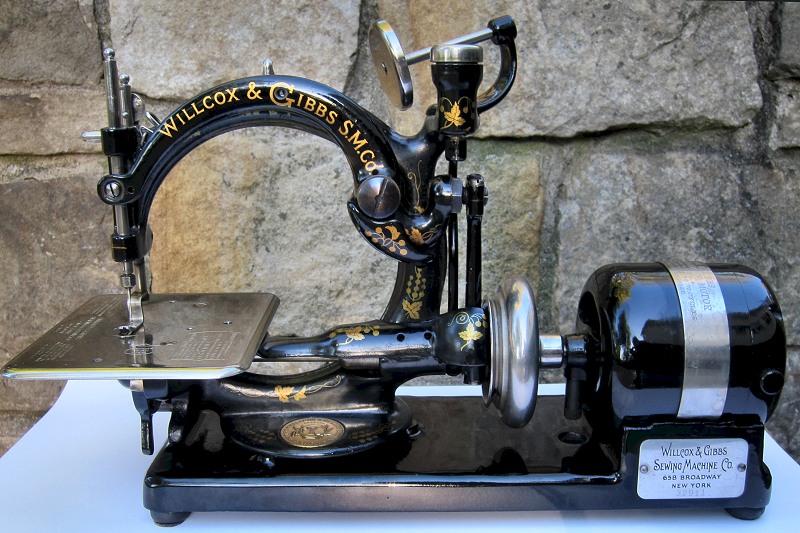
Front 
Back 
Back to Index
|







